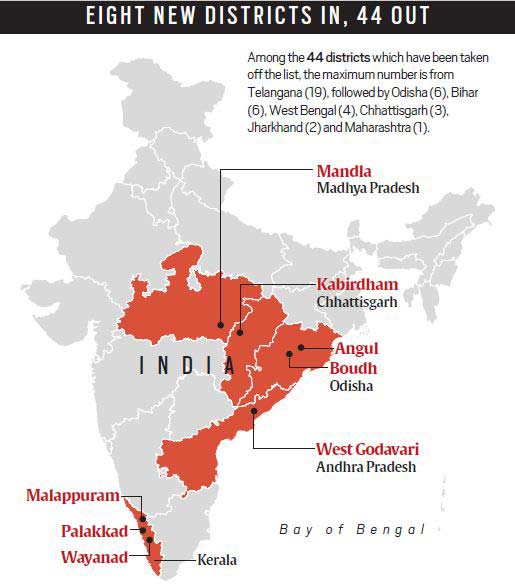Context:
- Naxalism was once called by the government as the biggest internal security threat faced by the country. However, according to the Ministry of Home Affairs (MHA), Maoist influence has been gradually shrinking. In figures released on Monday, the MHA, which recently redrew the red corridor, brought down the number of districts affected with Naxal violence from 106 to 90, spread across 11 states. The list also includes the 30 worst-affected district — six down from the previous one.
- In 2015, the NDA government had adopted the ‘National Policy and Action Plan’, which aimed at addressing Left Wing Extremism (LWE) in the country. In the last couple of years though, Maoists have managed to carry out big strikes killing scores of policemen. In Chhattisgarh, over two dozen policemen were killed in separate incidents in 2017; at least nine CRPF personnel were killed in a similar attack in Sukma last month.
Which states are included in the LWE-affected areas?
- The report considers Chhattisgarh, Jharkhand, Odisha and Bihar as states that are severely affected by LWE. West Bengal, Maharashtra and Andhra Pradesh (earlier a part of the severely affected category) are considered partially affected. Uttar Pradesh and Madhya Pradesh are classified as states that are slightly affected.
- According to the report, Maoists are making a foray into Kerala, Karnataka and Tamil Nadu, and planning to link the Western and Eastern Ghats through these states. They are not only planning to increase their activities in these areas, but also carve out a base for themselves in the tri-junction. The report also notes that the Maoists are attempting to make inroads into Assam and Arunachal Pradesh, and their success in doing so can have long-term strategic implications.
Is the recently drawn red corridor different from the older one?
- In 2015, the total number of LWE-affected districts was 106. It rose to 126 in 2017 following bifurcation of states and districts, and the expansion of Maoists activities. All expenses incurred by the affected areas are covered under the Security Related Expenditure (SRE) Scheme of the MHA, which provides funds for transportation, communication, hiring of vehicles, stipend for surrendered Maoists, and temporary infrastructure for security forces.
- Of the 106 districts, 36 accounted for 80 to 90% of the country-wide LWE violence, and were categorized as “Worst Affected Districts”. In its recent review, the Home Ministry noted that 44 of the 126 districts reported negligence violence, and they were removed from the list. Eight new districts which witnessed Maoist movements were added to the SRE list. Currently, 30 instead of 36 of the worst affected districts account for 90% of the LWE violence.
So, which are the new districts where Maoists are making inroads?
Eight new districts have been included by the MHA.
Kerala: Malappuram, Palakkad and Wayanad
Andhra Pradesh: West Godavari
Chhattisgarh: Kabirdham
Madhya Pradesh: Mandla
Odisha: Angul and Boudh

Which are the districts that have now been excluded?
As many as 44 districts have been removed from the list. Among them the majority belongs to the following states:
* Telangana: 19 districts
* Odisha: 6 districts
* Bihar: 6 districts
* West Bengal: 4 districts
* Chhattisgarh: 3 districts
* Jharkhand: 2 districts
* Maharashtra: 1 district
What were the criteria for removing the districts and including new ones?
- The primary criterion was ‘incidents of violence’. The 44 districts, which have been excluded, did not report any significant incidents of violence due to LWE in the last three years.
- Similarly, three new districts in Kerala were added following reports of Naxal movement, and their overground activities. Incidents of violence have seen a 20% decline with a 34% reduction in related deaths in 2017 as compared to 2013. The geographical spread of LWE violence also shrunk from 76 districts in 2013 to 58 districts in 2017. The new districts will receive the SRE fund from the Centre, which will monitor development and security-related projects. Last year, the combined SRE expenditure in LWE-affected districts was Rs 445 crore.
What is the multi-pronged strategy of the government?
- The multi-pronged strategy primarily includes development and security aspects of affected districts. Projects related to development include infrastructure, roads, cellphone connectivity, bridges and schools. As per MHA data, 2,329 mobile towers were installed in Maoist-affected areas in the first phase of the project aimed at improving cellphone connectivity, with the maximum number of towers being installed in Jharkhand (816), followed by Chhattisgarh (519). In the second phase, the government plans to install another 4,072 mobile towers.
- Similarly, 4,544 kilometers of road have already been built of the sanctioned 5,422 km. The second phase of constructing 5,411 km of road will start soon, and is estimated to cost Rs 10,780 crores.
- Earlier, 11 of the 36 worst affected areas had no Kendriya Vidyalaya (KV), and only six Jawahar Navodaya Vidyalayas (JNVs). Now, all the 36 districts have JNVs, and eight districts have functional KVs. Three new KVs are also being built.
- Eight bridges, which were built to enhance connectivity to remote areas in LWE-affected states, were constructed at a cost of nearly Rs 1,000 crores.
THE 30 MOST AFFECTED LWE DISTRICTS NOW
Andhra Pradesh: Vishakhapatnam
Bihar: Aurangabad, Gaya, Jamui, Lakhisarai
Chhattisgarh: Bastar, Bijapur, Dantewada, Kanker, Kondagaon, Narayanpur, Rajnandgaon, Sukma
Jharkhand: Bokaro, Chatra, Garhwa, Giridih, Gumla, Hazaribagh, Khunti, Latehar, Lohardaga, Palamu, Ranchi, Simdega West, Singhbhum
Maharashtra: Gadchiroli
Odisha: Korapur, Malkangiri
Telangana: Bhadradri, Kothagudem
Source:IE
